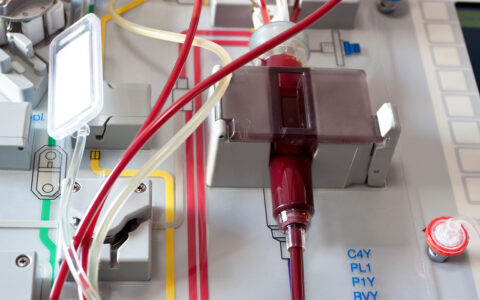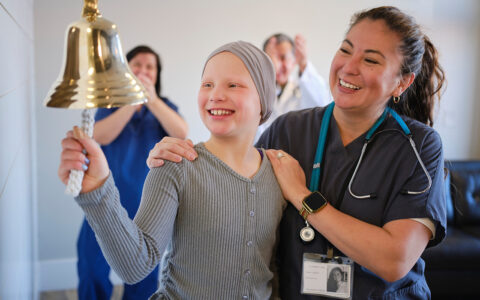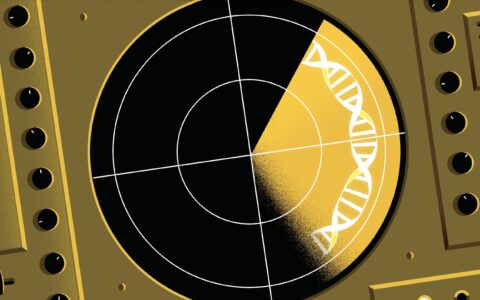Children with cancer, particularly those who have undergone hematopoietic stem cell transplant (HSCT), are highly susceptible to bacterial and fungal infection and may develop prolonged febrile neutropenia.
Although most of the episodes resolve within 96 hours with broad-spectrum antibiotics, a sizable portion continue to have fever beyond four days, raising the concern for invasive fungal disease (IFD) and other infections.
Evaluation for IFD is especially challenging. Current guidelines recommend an evaluation and, pending results, potentially starting antifungal therapy empirically.
In 2023, Adam Esbenshade, M.D., M.S.C.I., a pediatric hematologist and oncologist at Monroe Carell Children’s Hospital at Vanderbilt, published a study on testing for fungal disease in this population.
“Currently, we are lacking clear guidance on the differential diagnoses of fungal infection, and we should question the practice of just changing antibiotics when the patient isn’t responding,” Esbenshade said. “But the yield on some of the IFD diagnostic tests appears to be low, so we wanted to use our data to evaluate the utility of each method.”
IFD on the Radar
While rare in the general pediatric population, fungal infections occur more often in children with cancer, particularly among those who have undergone hematopoietic stem cell transplant (HSCT). Central lines are a major source of opportunistic fungi, as well as bacterial infections.
“When a child has neutropenia and a fever that persists beyond 96 hours, even after getting a broad-spectrum antibiotic, they should be evaluated for a refractory bacterial infection like typhlitis, but also for fungal disease,” Esbenshade said.
Treatment strategies have been shifting from wait-and-see toward pre-emptive therapy for probable IFD with agents like azole and echinocandin antifungals and non-drug treatment. Amphotericin or the newer isavuconazole are reserved for serious, confirmed IFD diagnoses.
A definitive diagnosis of fungal disease can be elusive because it requires microscopic visualization of a fungus from a sterile site or a positive fungal culture. Since invasive bronchoalveolar lavage (BAL) or lung biopsy are needed to retrieve specimens, other tests are typically relied upon to help make what is often a diagnosis that excludes or finds evidence of probable IFD.
The most commonly used first-line diagnostics are the sinus CT, chest CT, abdominal/pelvic CT, and the beta-D-glucan and galactomannan tests.
“When a child has neutropenia and a fever that persists after 96 hours, even after getting a broad-spectrum antibiotic, they should be evaluated for a refractory bacterial infection like typhlitis, but also for fungal disease.”
Predictive Values
Esbenshade and his team studied 1,478 episodes of febrile neutropenia, evaluating the predictive value of both positive and negative test outcomes in identifying bacterial infections and IFD. About a third of cases met the criteria for inclusion. An IFD evaluation of some kind was performed in 64 percent of these episodes.
Among these 322 cases, 36 percent had a documented infection, including Clostridioides difficile colitis (6.4 percent), true bacterial bloodstream infections (5.2 percent), proven or provable IFD (4.8 percent), or a positive respiratory pathogen panel (3.6 percent).
The sinus CT, commonly used as a first test for IFD, made no significant contribution to the diagnosis of IFD or other infectious agents.
“In the 100-plus times we ordered a sinus CT, it never helped us get to a fungal disease diagnosis,” Esbenshade said.
In contrast, the chest CT had a positive predictive value of 19 percent for nodules and 14 percent for tree and bud lesions. It also diagnosed possible pneumonia in 25 percent of the episodes. Abdominal/pelvic CTs yielded high levels of infection diagnoses – 32 percent – but was not useful in diagnosing IFD.
Importantly, the blood/specimen tests for glactomannan, beta-D-glucan and fungal polymerase chain reaction had very low sensitivity and specificity.
Fungal Findings
The team found proven or probable IFD in 24 episodes, with Candida and Aspergillus most common. Disseminated disease was found in 58 percent of episodes, and the most prevalent sites of infection were the lung (n = 14), followed by the GI tract (n = 9), spleen (n = 7), and brain (n = 6).
Interestingly, another 28 episodes had been treated as IFD even though they did not meet the full criteria.
Ninety-two cases occurred in stem-cell transplant patients, with IFD in seven of those, most of which occurred early – less than 10 days – after transplant. Unsurprisingly, given their need for aggressive immunosuppression, patients who had received an allogeneic HCST were more susceptible to fungal infection than the overall study population, with the highest rates among acute lymphocytic leukemia patients, 58.3 percent versus 32.2 percent.
“Anti-fungal drugs are not without risk and some of them lower electrolytes significantly, so it is in the patient’s interest to try to identify IFD instead of treating it empirically,” Esbenshade said.
Over the past several years, Esbenshade has published many studies on how to optimize the diagnosis and treatment of children with cancer and febrile neutropenic. His goal is to offer reliable models for diagnosis and treatment upon presentation at a clinic or ED.




